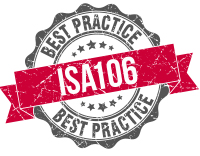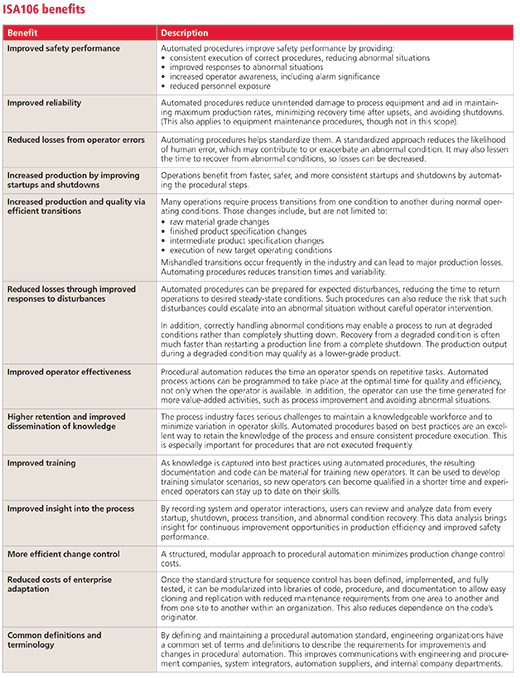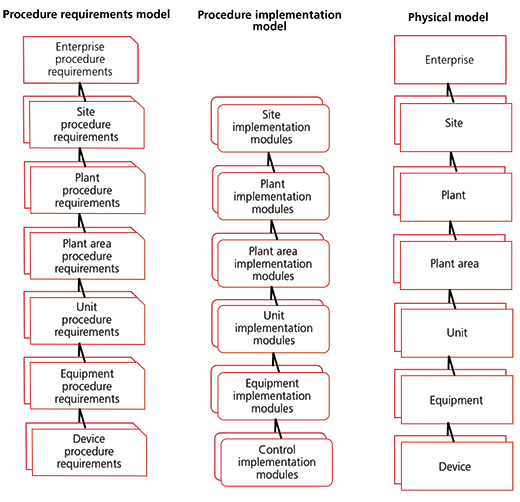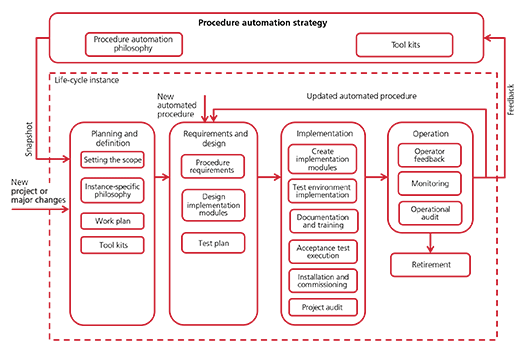- By Bill Wray, PE, Yahya Nazer, PhD
- System Integration
Summary
Fast Forward
- ISA-106 provides a common basis of understanding of the benefits, best practice application, and language for continuous process industries.
- Procedures are important for consistency and quality operations.
- Systemizing procedures preserves knowledge and know-how of experienced people; this is important with the large numbers of retiring people.
ISA-106 for design and implementation of procedures
By Yahya Nazer, PhD, and Bill Wray, PE

- models and terminology
- modularization of procedural steps to foster reuse and lower total cost of ownership
- exception handling for abnormal situations
- physical, procedural, and application models
- process unit orientation with operational perspective
- recommended best practices
- implementation of startup, shutdown, abnormal situations, hold states, and transition logic
- recommended target platform (i.e., control system versus safety system) for different types of procedures
- life-cycle management best practices
- training and certification best practices
The main driver for ISA106 is to enable the control engineer to implement:
- repeatable and optimized startup, run, state transition, and shutdown procedures
- abnormal situation management using additional control strategies
- intelligent alarming based on mode of operation
- equipment, devices, and controllers that are automatically enabled based on mode of operation
- redundant equipment (such as pumps) that can be automatically swapped for maintenance, run-time balancing, failure recovery, or other reasons
- control systems that allow operators to run a process unit as a unit instead of manipulating individual devices
- startup and shutdown procedures (which may be infrequent), including automatic sequencing of the plant (unit to unit)
Models and terminology
The first technical report written by the ISA106 committee, ISA-TR106.00.01-2013, Procedure Automation for Continuous Process Operations - Models and Terminology, complements the concepts described in several key ISA standards. It addresses the subject of procedural automation for continuous process operations and is focused on a collection of good practices regarding procedural automation in process operations and strategies for incorporating automated procedures into industrial automation and basic process control systems (BPCS). Other standards deal with the use of procedures in specific applications, among them batch processing and safety systems. Many of the fundamental concepts discussed in these standards are common to all procedures without regard to the context, but there are needs specific to continuous processes. These needs are addressed in the procedure requirements model, the procedure implementation model, and the physical model, as well as in the subclause concerning mapping of procedures to BPCS components.
The scope of the technical report is to provide a common basis of understanding of the benefits, best practice application, and language (including terms and definitions) that will allow organizations to apply procedural automation across the continuous process industries.
This report focuses on automated procedures that primarily reside on systems within the supervisory control, monitoring, and automated process control section of the production process. The committee did not intend to focus this technical report on procedure execution at the operations management functional level. It does also focus on continuous processes. However, the contents of the report may be used in other types of process control, such as batch or discrete. The technical report is intended to be applicable to process control activities within the BPCS and safety instrumented systems. Required safety instrumented functions should be analyzed and implemented in accordance with ISA-61511 (ISA-84).

Three models are defined for procedural automation of continuous process operations.
- Procedure requirements model
The procedure requirements model depicts how procedure requirements map to the hierarchy of equipment shown in the physical model. - Procedure implementation model
The procedure implementation model serves as the connection between the procedure requirements model and the physical model, as illustrated below. - Physical model
The physical model depicts how the ISA-95 role-based equipment model is applied to continuous process operations within this technical report.

Work processes
The work of ISA106 is intended to provide a framework for building process operating knowledge into automated procedures. This is especially important for such plant procedures as startup, shutdown, and product grade change-as studies have shown that plants are particularly vulnerable to safety incidents caused by inexperienced operators performing unfamiliar manual functions during such key procedures.
Building on the models and terminology of its first technical report, the ISA106 committee has completed a second technical report that describes work processes involved with automating procedures for monitoring and controlling continuous processes. ISA-TR106.00.02-2017, Procedure Automation for Continuous Process Operations - Work Processes, applies to new process facilities and to control upgrades in existing facilities.
This technical report is not intended to instruct organizations on how to identify and justify projects or to provide the details of work processes, but rather to set forth a generic set of work processes to guide procedure automation project execution phases. The primary intended audience is technical managers, project managers, and engineering personnel responsible for the automation of continuous process operations in new and existing plants.
"The work processes used by end users are critical for the successful completion of capital projects and projects funded out of operating expenses," points out ISA106 member Dave Emerson of Yokogawa. "The new technical report provides a guide to how end users' work processes can be designed to account for the automation of continuous process operations. It reflects the combined knowledge and foresight of engineers from many different end users, automation suppliers, and consultants. The knowledge in this technical report can and should be used by owner operators to improve their own work processes, by automation suppliers to improve products and services, by consultants to help improve end users, and by automation suppliers to make the process industries safer and more efficient."
This technical report organizes work processes for developing and maintaining automated procedures into a life-cycle reference model in order to provide context to work processes and make them more sustainable. The life-cycle reference model described in this technical report is intended to be incorporated into an operating organization's project methodology, such as common gate-oriented or "V model" project methodologies.
Integrating the life-cycle reference model and associated work processes into an organization's project methodology is a critical factor for achieving financial and operational success with procedure automation. The life-cycle reference model and associated work processes may be scaled up, for large and "mega" projects, or scaled down for operational activities.
In the ISA-106 automated procedure life-cycle reference model, the rounded rectangles represent the work processes, or their deliverables, that are directly related to the life-cycle of automated procedures.
The intended audience for this report includes technical and operations managers and engineering personnel who are responsible for the operation or automation of continuous process operations, members of engineering departments of owner operators, and engineering personnel of engineering and procurement companies, automation vendors, system integrators, and other process engineering practitioners.

Path forward
In the two ISA-106 technical reports, the committee focused on the current state of the continuous process industries. ISA106 is now working on a requirements-based standard. The models and terminology in the first technical report will be reviewed and revised as needed, and the committee will factor in the experiences and ideas gained in usage. The standard will also reflect the work processes set forth in the new technical report.
ISA106 is currently working on early drafts of the standard and welcomes new participants, especially end users to share their expertise and experiences. The committee currently has 168 members, including 25 voting members, with 45 percent of members representing owner-operator companies. The authors also acknowledge ISA106 secretary Charlie Green and editor Dave Emerson. For more information, contact ISA106 co-chairs Yahya Nazer or Bill Wray. To view or obtain copies of the two ISA-106 technical reports, visit www.isa.org/findstandards.
Reader Feedback
We want to hear from you! Please send us your comments and questions about this topic to InTechmagazine@isa.org.


